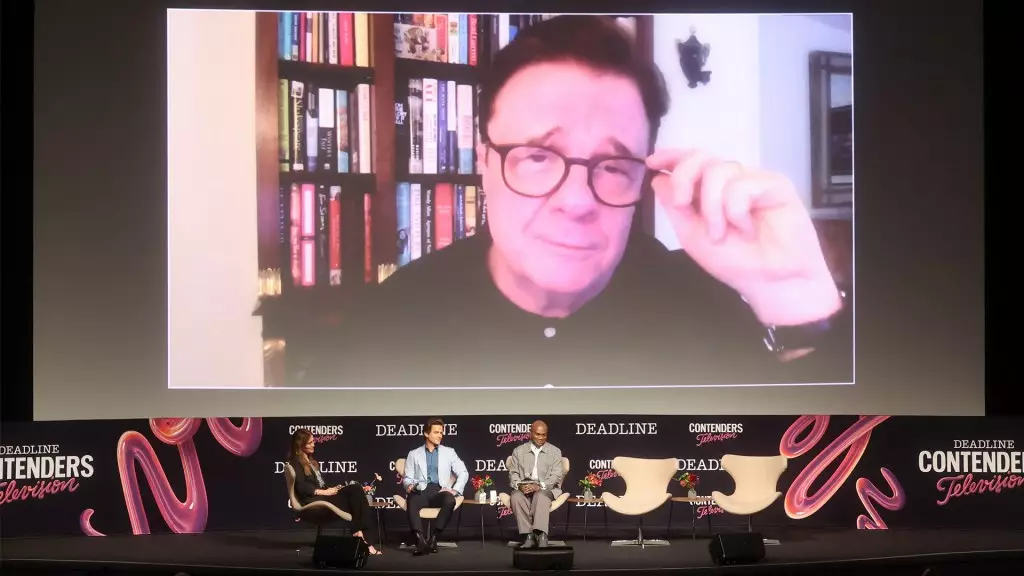In a world where the political landscape continues to present challenges for the LGBTQ+ community, the emergence of shows such as *Mid-Century Modern* is not merely welcome; it is essential. The trio behind this groundbreaking sitcom—Nathan Lane, Matt Bomer, and Nathan Lee Graham—aligns in their affirmations of the role this show plays in echoing the joys and struggles of being queer in a society that sometimes feels antagonistic toward difference. In a recent panel discussion at Deadline’s Contenders TV event, the actors expressed how impactful it is to present a narrative filled with humor and heart at a time when authenticity is under pressure. They share an understanding that the sitcom format can serve as both a mirror and a shield; it reflects the complexities of life while also providing a necessary escape.
Nathan Lane’s articulation of the current climate resonates with many who find themselves navigating a society that increasingly pushes back against progress. With his comedic timing and earnest sentiment, he remarked on the urgency of the show’s message, suggesting that in dark times, laughter becomes a form of resistance. Lane’s characterization of the situation as an “authoritarian regime” speaks volumes about the feelings of citizens today, suggesting that humor can be both a reprieve and a platform for activism.
Creating Joy and Empowerment through Comedy
*Mid-Century Modern* takes us on a poignant journey with three older gay men who redefine their lives after the loss of a close friend. Set against the vibrant backdrop of Palm Springs, the show presents Bunny, Jerry, and Arthur as a “found family,” embodying the truth that love and companionship extend beyond traditional boundaries. The chemistry between Lane, Bomer, and Graham elevates the series, allowing it to be both entertaining and insightful.
Bomer’s assertion that the series brings “a little queer joy” is not just an optimistic statement; it highlights the importance of joy in advocacy. When queer stories are told through the lens of laughter and warmth, they become more accessible to a wider audience. This strategy of embedding significant issues within the fabric of comedic storytelling enables viewers to engage with complex themes while allowing themselves to laugh, celebrate, and reflect.
Graham poignantly notes the importance of portrayal without shame. This aspect can be liberating for actors and viewers alike, breaking down the stigma associated with queer identities. By stepping into roles that celebrate the multifaceted nature of gay life, the actors help redefine perceptions—not just for themselves but for those who watch with open minds and hearts.
Legacy and Tribute to Greatness
The show is also enriched by the late Linda Lavin’s portrayal of Bunny’s mother, Sybil. Her unexpected passing during the show’s production serves as a reminder of the fragility of life and the importance of honoring legacies. In this context, the show’s ninth episode takes on an even deeper significance as it confronts the realities of grief and loss while still enveloping the audience in laughter.
Ryan Murphy and the *Will & Grace* creators, Max Mutchnick and David Kohan, skillfully weave together an engaging narrative that resonates within and beyond the LGBTQ+ community. Their ability to create a heartfelt, multi-dimensional portrayal of its characters speaks to the power of inclusive storytelling. Lavin, remembered for her extraordinary talents, leaves a legacy that will linger long after the show ends—a reminder of both the fragility of life and the resilience of love and laughter.
A Platform for Authentic Voices
Yet, as with any new cultural phenomenon, *Mid-Century Modern* faces its share of skepticism. Some critics suggest it relies on traditional sitcom tropes, including canned laughter. However, Graham quickly debunks the misconception, clarifying that laughter comes from a live audience, grounding the show in authenticity. This speaks to a larger issue within media: the importance of genuine audience interaction and how it influences the viewing experience.
The combination of heartfelt storytelling, layered characters, and the topical relevance of *Mid-Century Modern* creates not just entertainment but a necessary dialogue about identity, loss, and community in today’s world. In a time when the LGBTQ+ narrative is threatened, this sitcom stands as an audacious proclamation of resilience, joy, and the radiant power of love illuminating even the darkest corridors of life. The show serves not merely as a source of comic relief, but as an emblem of hope, empowerment, and authenticity, reminding us why storytelling matters profoundly.

Leave a Reply